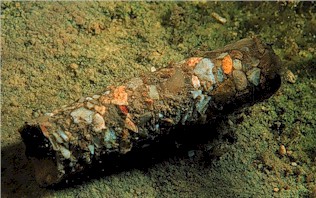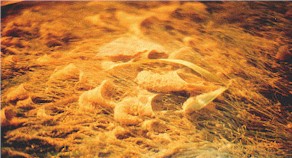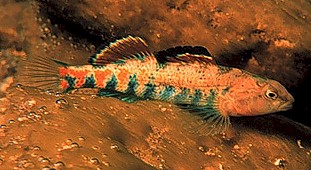Insects Need Riparian Zones
Riparian zones are areas of high terrestrial and aquatic insect densities. The increased number of insects found near riparian areas provides a food source for insectivore species including birds such as woodpeckers, shrews, and bats. |
|||
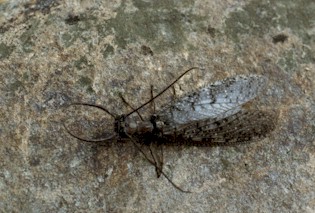 Male dobsonfly on rock in Big Darby Creek, Ohio; Jay DeLong photo |
Riparian zones provide breeding habitat for many insect species. Many insects lay their eggs in leaf litter along the shore. The insect pictured at left is the dobsonfly Corydalus, found through the eastern United States. The pincer-like appendages found on males likely serve for subduing the female while mating. | ||
| The dobsonfly is the adult of the aquatic insect larvae commonly known as the hellgrammite. Dobsonfly adults primarily lay their eggs on leaves or branches overhanging the water, and will also use bridge abutments. | 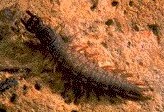 Hellgrammite in Kansas stream; Garold W. Sneegas photo |
||
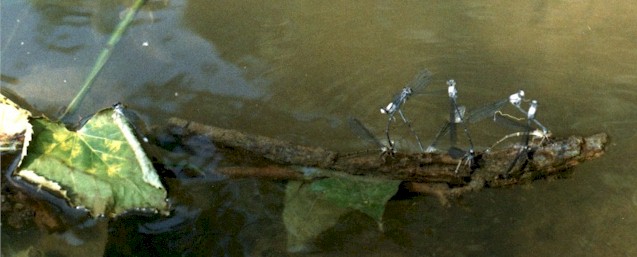
Damselflies mating on woody debris in an Ohio stream;
Jay DeLong photo
| The damselflies and their relatives the dragonflies frequently seen buzzing
around ponds, lakes or streams have aquatic larvae which find food and cover in submerged
plants and woody debris. But the value of forest debris to damselflies and other aquatic insects is far more complex than providing habitat, because organic matter input from the riparian zone, primarily leaf litter from trees, is the basis of a food chain in a diverse stream community. |
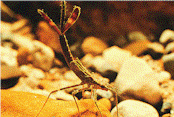 Damselfly larvae; Ohio Dept. of Natural Resources photo |
|
||
The Trichoptera, or caddisflies, is one of the largest groups of aquatic insects. More than 1,200 species are now known in North America north of the Rio Grande River. The larvae are highly specialized for food acquisition. Some build cases from small pebbles, leaves, or twigs held together by silk produced by the larvae. These cases help camouflage the larvae and protect them from predators as they walk about grazing on fine particulate organic material and diatoms. Other caddisfly species like the one below build silk nets to trap detritus. Still others are predaceous, building and waiting within silk tubes having external threads to detect the presence of prey.
|
This is
particularly true in headwater streams, which are characterized by little or no other
nutrient sources, a closed shade-producing canopy, and low water temperatures. These cool,
shaded waters contain an active community of bacteria and a group of
macroinvertebrates known as shredders (many species of beetles, flies and caddisflies,
among others) which reduce the riparian litter to smaller particles which become the food
for other invertebrates downstream. Further downstream as the stream widens and more light penetrates the water, diatoms and other algae supplement detritus as a food source. Here, other groups of invertebrates known as collectors (such as the net-spinning caddisfly at left) become more abundant in the community, along with invertebrates known as scrapers (including many mayfly species) that feed directly on the algae, bacteria, and decomposing plant material. At some point downstream, in the middle reaches well before it become riverine in appearance, the stream's highest species diversities occur-- but not just of insects. Depending on the part of the continent, fish populations of darters, minnows, sculpins, and others, are at their greatest diversities as well. |
|
|
Therefore, to continue building on the idea that "Insects need riparian zones" is far too simple of a way of looking at the complex nature of stream ecosystems. A healthy and diverse stream is a community of plants, animals, microorganisms and more. The stream ecosystem provides for and depends upon all of its plant and animal life, and this involves riparian vegetation input, processing, and transfer through the system. One way to look at it is that riparian vegetation becomes insects and fishes and crustaceans and amphibians and reptiles and all that is part of the ecosystem.
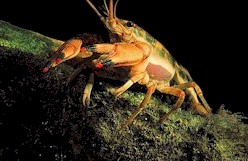 Kansas crayfish; Garold W. Sneegas photo |
 Midwest two-lined Salamander; Guy Denney photo |
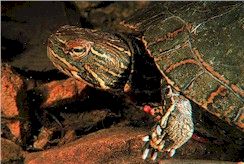 Western painted turtle; Garold W. Sneegas photo |
© Robert Carillio s_r_enterprises@hotmail.com and Jay DeLong thirdwind@att.net
